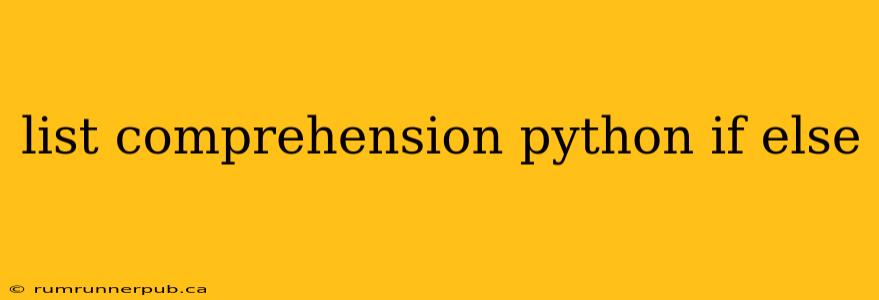Python's list comprehensions offer a concise way to create lists. They become even more powerful when combined with if-else statements, allowing for complex list transformations in a single line of code. This article explores how to effectively use if-else within list comprehensions, drawing upon insights from Stack Overflow and adding practical examples.
The Basics: Simple List Comprehensions
Before diving into if-else, let's refresh the fundamentals. A simple list comprehension takes the form:
new_list = [expression for item in iterable]
This iterates through iterable (like a list or range), applies expression to each item, and adds the result to new_list.
Example:
numbers = [1, 2, 3, 4, 5]
squared_numbers = [x**2 for x in numbers] # Output: [1, 4, 9, 16, 25]
Incorporating if Conditions
Adding an if clause allows filtering elements:
new_list = [expression for item in iterable if condition]
Only items satisfying condition are included.
Example:
even_numbers = [x for x in numbers if x % 2 == 0] # Output: [2, 4]
The Power of if-else: Conditional Expressions
This is where list comprehensions truly shine. The if-else construct within a list comprehension uses a conditional expression:
new_list = [expression1 if condition else expression2 for item in iterable]
This applies expression1 if condition is true, otherwise expression2. This elegantly handles two different outcomes based on the condition.
Example (inspired by Stack Overflow discussions regarding conditional list creation):
Let's say we want to create a list where even numbers are doubled and odd numbers are tripled. A typical approach without list comprehension might involve a loop:
numbers = [1, 2, 3, 4, 5]
result = []
for x in numbers:
if x % 2 == 0:
result.append(x * 2)
else:
result.append(x * 3)
print(result) # Output: [3, 4, 9, 8, 15]
With a list comprehension and if-else, it becomes remarkably concise:
result = [x * 2 if x % 2 == 0 else x * 3 for x in numbers]
print(result) # Output: [3, 4, 9, 8, 15]
This approach is significantly more readable and efficient. (Note: While this example is simple, the advantages of list comprehension become even more pronounced with more complex transformations.)
Nested List Comprehensions with if-else
The power of if-else extends to nested list comprehensions, enabling sophisticated multi-dimensional data manipulation. However, readability becomes crucial. Overly complex nested comprehensions can be difficult to understand.
Example: Let's transpose a matrix:
matrix = [[1, 2, 3], [4, 5, 6], [7, 8, 9]]
transposed = [[row[i] for row in matrix] for i in range(len(matrix[0]))]
print(transposed) # Output: [[1, 4, 7], [2, 5, 8], [3, 6, 9]]
Adding an if-else here could, for instance, conditionally alter elements based on their row or column index. However, in such scenarios, breaking the logic into smaller, more manageable functions often improves readability and maintainability, even if it means sacrificing the one-liner aspect of a list comprehension.
When to Avoid List Comprehensions
While powerful, list comprehensions aren't always the best choice. For extremely complex logic, or when performance is critical with massive datasets, a well-structured loop might be preferable for clarity and optimization. Profiling your code can help determine the best approach.
Conclusion
Python list comprehensions combined with if-else statements are a versatile tool for concise and efficient list manipulation. Understanding their capabilities and limitations is key to writing elegant and performant Python code. Remember to prioritize readability, especially when dealing with nested structures. By mastering these techniques, you'll significantly enhance your Python programming skills.
